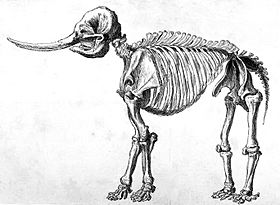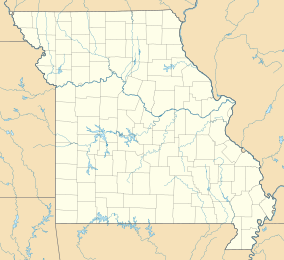Mastodon State Historic Site facts for kids
Quick facts for kids Mastodon State Historic Site |
|
|---|---|

Skeleton museum display
|
|
| Location | Jefferson County, Missouri, United States |
| Area | 431.14 acres (174.48 ha) |
| Elevation | 417 ft (127 m) |
| Established | 1976 |
| Visitors | 677,188 (in 2022) |
| Operator | Missouri Department of Natural Resources |
| Website | Mastodon State Historic Site |
|
Kimmswick Bone Bed
|
|

Drawing of a mastodon skeleton by Rembrandt Peale
|
|
| Location | Jefferson County, Missouri, USA |
| NRHP reference No. | 80002371 |
| Added to NRHP | November 5, 1980 |
Mastodon State Historic Site is a super cool park in Imperial, Missouri. It's managed by the Missouri Department of Natural Resources. This special park is about 431 acres big. It's a place where scientists study old things like bones and tools.
The park protects a famous spot called the Kimmswick Bone Bed. Here, people first found bones of mastodons and other animals that no longer live on Earth. This happened way back in the early 1800s!
The area became famous as one of the best places in the country to find Ice Age fossils. Scientists from all over the world became interested in it.
The state bought the site in 1976 to save it from being destroyed. This happened when a new highway, Interstate 55, was being built.
In 1979, something amazing happened at the site. Scientists found a stone spear point from ancient hunters (called the Clovis culture) right next to mastodon bones. This was super important! It was the first clear proof that people and giant mastodons lived at the same time. The Kimmswick Bone Bed was added to the National Register of Historic Places in 1987.
Exploring the Park: Things to Do
There's a museum at the site that tells the story of the park. You can learn about the natural history and the oldest American Indian site in Missouri's park system.
A full-size model of a mastodon skeleton is a highlight of the museum. It helps you imagine these huge animals!
The park also has a picnic area where you can eat. There are hiking trails to explore the land. You can walk where ancient Native Americans and mastodons once lived. There's even a special campground if you want to stay overnight.



